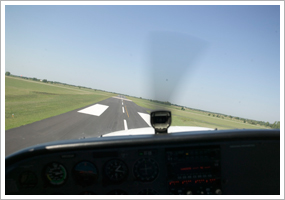| The following stories from the February 26, 2010, edition of AOPA ePilot were provided to AOPA members who expressed an interest in the particular subject areas. Any AOPA member can receive information tailored to their areas of interest by updating their preferences online. TRAINING TIPsDemonstrated crosswind velocity
A working definition of the term comes from the Feb. 27, 2004, “Training Tip” on calculating crosswind components: "One manufacturer defines this as ‘the velocity of the crosswind component of which adequate control of the airplane during takeoff and landing was actually demonstrated during certification tests.’ Although it is not an operating limitation, it deserves your respect; new pilots and especially students should not try to test it.”
The observation that maximum demonstrated crosswind velocity is not an operating limitation is the most commonly recited fact about the number, which for a 1977 Cessna 150 Commuter is 13 knots. Indeed, the number typically appears among performance criteria, not limitations, in pilot’s operating handbooks.
Well, the designated examiner might ask, what does that mean? Should you just ignore it? Of course not. Here’s what AOPA Air Safety Foundation President Bruce Landsberg said about demonstrated crosswind velocity in the July 2000 AOPA Flight Training article “Charting the wind”: “The numbers are usually fairly high. For example, the Cessna Turbo 210 was tested to land safely in 21 knots of direct crosswind. For most of us, that will probably suffice on a day-to-day basis, and the majority of CFIs recommend that demonstrated crosswind be considered the aircraft's limit.”
One little-known fact is how the demonstrated crosswind velocity standards are satisfied during aircraft-certification tests. You’ll impress your examiner by providing this information from Chapter 10 of the Pilot’s Handbook of Aeronautical Knowledge : “Every aircraft is tested according to FAA regulations prior to certification. The aircraft is tested by a pilot with average piloting skills in 90-degree crosswinds with a velocity up to 0.2 V so or two-tenths of the aircraft’s stalling speed with power off, gear down, and flaps down. This means that if the stalling speed of the aircraft is 45 knots, it must be capable of landing in a 9-knot, 90-degree crosswind. The maximum demonstrated crosswind component is published in the AFM/POH.”
In context, the maximum demonstrated crosswind velocity is a meaningful number to know! TRAINING PRODUCTS‘21st Century Flight Training’Since we’re now 10 years into the new millennium, it seems to be time for a book on training in this century. Author and instructor Sean Lane tackles the idea in his new book, “21st Century Flight Training.” Lane covers the basic maneuvers that you’ll find in almost any aviation text, but he tries to go beyond that with a more mind-based approach. He includes heavy references to aeronautical decision making and something he calls integrated sensory flying. It’s a good reference for anyone looking for just a little bit more out of his or her textbook. You can order it for $29.95 from Aviation Supplies & Academics.
Note: Products listed have not been evaluated by ePilot editors unless otherwise noted. AOPA assumes no responsibility for products or services listed or for claims or actions by manufacturers or vendors. FINAL EXAMQuestion: I am a student pilot and I was listening to some other pilots talk about recent trips they had taken. One mentioned an airport that he flew into recently that had a very narrow runway. He mentioned something about runway width illusions. What was he talking about?
Answer: There are a couple of runway width illusions that a pilot can encounter. One is associated with a runway that is narrower than usual. This situation can create the illusion that the aircraft is higher above the ground than it actually is. If the pilot doesn’t recognize it, a lower approach might be flown, thereby increasing the risk of striking obstacles along the approach path or of landing short. A runway that is wider than usual can create the opposite illusion, causing a pilot to flare too high and land hard or even overshoot the runway. You’ll find more information on illusions in flight in the Aeronautical Information Manual, Chapter 8-1-5.
Got a question for our technical services staff? E-mail [email protected] or call the Pilot Information Center, 800/872-2672. Don’t forget the online archive of “Final Exam” questions and answers, searchable by keyword or topic. |
 Let’s continue with our recent review of aeronautical terminology intended to help you prepare for an FAA knowledge or practical test. Here is another aircraft performance value that you might be asked to explain and interpret: your aircraft’s maximum demonstrated crosswind velocity.
Let’s continue with our recent review of aeronautical terminology intended to help you prepare for an FAA knowledge or practical test. Here is another aircraft performance value that you might be asked to explain and interpret: your aircraft’s maximum demonstrated crosswind velocity.